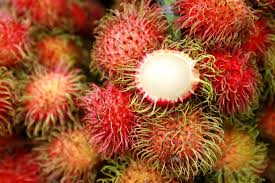[spiky yellow fruit]Dragon fruit looks like a stylized fire, rambutan hairy or Salak fruit with skin like snakes ... are the fruits with the most bizarre shape in the world.
Kiwano
Kiwano is a fruit quite similar to cucumber or watermelon and is native to Africa. It is considered the ancestor of other melons. When ripe, Kiwano looks yellow in appearance and grows many stubborn horns, while the inner intestine is green with a bitter taste. This is an edible fruit, but it is often used as a garnish. The fruit is currently grown in the United States, Chile, Australia, and New Zealand.
Dragon fruit
Also known as Pitaya, dragon fruit has a red appearance like a stylized fire. The fruit is native to Mexico, Central and South American countries, but is now widely grown in Southeast Asia, southern China, Australia, and even Israel. Inside the dragon's intestine, there are seeds like black sesame and have a sweet, sweet aroma.
Durian
Durian is a fruit tree of the genus Durio (durian genus), which is widely known in Southeast Asia. Durian has a large trunk, a unique smelling fruit, and a shell of many spines. The fruit is oval to round, with a length of 30 cm, a diameter of 15 cm and a weight of 1 to 2 kg. The durian fruit is usually light yellow in color. Despite being a delicious fruit, its taste can make many people unbearable and has been banned from appearing in public places in countries such as Brunei, Indonesia, and Malaysia.
Rambutan
Rambutan is a tropical plant in Southeast Asia. The name Rambutan symbolizes the furry state of this tree fruit. The coat is also a basic feature of the Malay name: rambutan (furry fruit). Today, rambutans are grown in latitudes from 15 ° South to 15 ° North, including Africa, Oceania, Central America and especially increasing in Australia and the Hawaiian Islands. Rambutan fruits grow in clusters of red, yellow or orange. The shell has many sharp, soft, curved hairs. Rambutan fruit has a juicy, slightly acidic taste.
Salak
Salak is a palm tree native to Indonesia. Salak trees have short stems with leaves about 6m long, each leaf has 2m long stalks, on which are 15cm long spines. The Salak fruit usually grows at the base of the tree and is called a snakeskin, because it has a reddish-brown crust. Cause and Effect Salak is sweet and acidic.

























COMMENTS